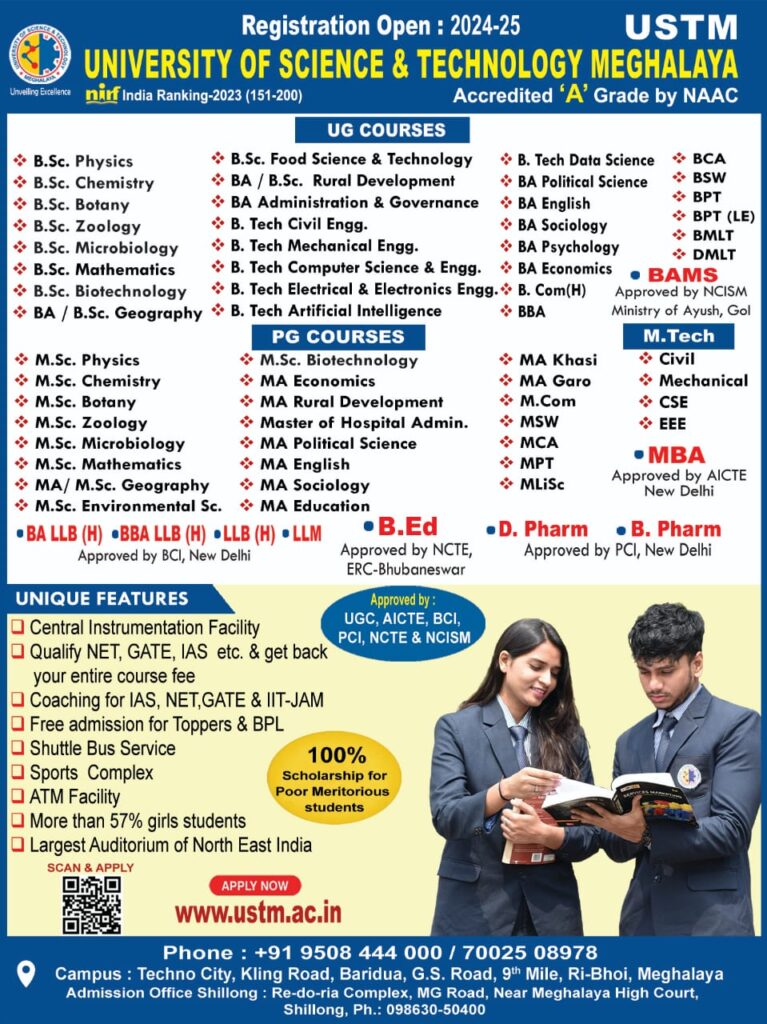Shillong, June 17: In Meghalaya, school dropout, early marriage and teenage pregnancy, low youth employment and high inactivity rates, mental health issues and drug abuse are some important challenges faced by adolescents and youth.
World Bank would be helping Meghalaya to improve adolescents’ well-being and their longer-term outcomes – such as an increase in marriage/child-bearing ages, greater human capital accumulation through increased time spent in education and increased productive capacity.
The total cost of the project is $62.50 million of which the Bank would be giving $ 40 million. The project is now at an appraisal stage.
“According to the 2011 Census, Meghalaya’s adolescent population comprises close to 24 per cent of the state population (around 710,000 boys and girls), with over 80 per cent living in rural areas, and 88 per cent belonging to STs. School dropout at the upper primary level is 11 per cent (12 for boys, 9 for girls), three times the national average, and 22 per cent at the secondary level (23 for boys and 20 for girls), close to double the national average. Early marriage remains common with nearly 1 in 6 adolescent girls married before the age of 18 and teenage childbearing is at 7 per cent” the World Bank project document says.

The document also says barriers to improving nutritional status among adolescents include poor diet, illiteracy, poor sanitation, and minimal coverage of interventions during early childhood and pregnancy. Early marriage remains common with nearly 1 in 6 adolescent girls married before the age of 18 and teenage childbearing is at 7 percent (NFHS 2019-21), both indicators following national trends.
The idea is to improve the capability of the State of Meghalaya to improve adolescents’ human capital outcomes.
The project will have four components- (1) Learning Mission, Life Skills, and Career Preparation in Schools (2)Community Interventions and pathways for out-of-school adolescents (3) State Capability and Program Management and Contingent Emergency Response Component (CERC) which will support an immediate response to an eligible crisis or emergency, as needed.

The first component will comprise three interrelated activities: (a) learning mission for upper primary schools, (b) life skills education through classroom sessions and in-school adolescent clubs, and (d) academic counselling and career readiness in secondary schools.
The first component will focus on improving human capital outcomes for adolescents in upper primary (grades 6-8), secondary (grades 9-10), and higher secondary (grades 11-12) government and government-aided schools in the state. This component will comprise three inter-related activities: (a) learning mission for upper primary schools, (b) life skills education through classroom sessions and in-school adolescent clubs, and (d) academic counselling and career readiness
in secondary schools.
The second component will focus on improving human capital outcomes for out-of-school adolescents as well as their parents, community members, and frontline workers with a special focus on out-of-school adolescents.

The third component will focus on strengthening the institutional capacity of the state for improved coordination, governance, and outreach, setting up Youth Centres as block-level hubs for adolescents and youth, and supporting improved management of data, and day to operations, and management of the project.
The Bank says Meghalaya’s adolescents will also face the burden of climate change effects as it is extremely vulnerable to climate-change-induced disasters. “The varied physiological features of the state and the altitudinal differences give rise to numerous types of climates ranging from near tropical to temperate and alpine, a pattern likely to be disturbed considerably by climate change,” it says.
Advertisement
The Bank says that the Government of Meghalaya is developing a long-term strategy to improve human capital outcomes of adolescents and youth through a range of enabling policies and programs but low coverage, fragmentation and targeting constraints of these programs limit their impact on addressing the growing human capital challenges faced by young people in the State.
Read: Manipur: Additional central forces deployed in violence-hit Jiribam to maintain peace
WATCH:
Find latest news from every corner of Northeast India at hubnetwork.in, your online source for breaking news, video coverage.
Also, Follow us on-
Twitter-twitter.com/nemediahub
Youtube channel- www.youtube.com/@NortheastMediaHub2020
Instagram- www.instagram.com/ne_media_hub





